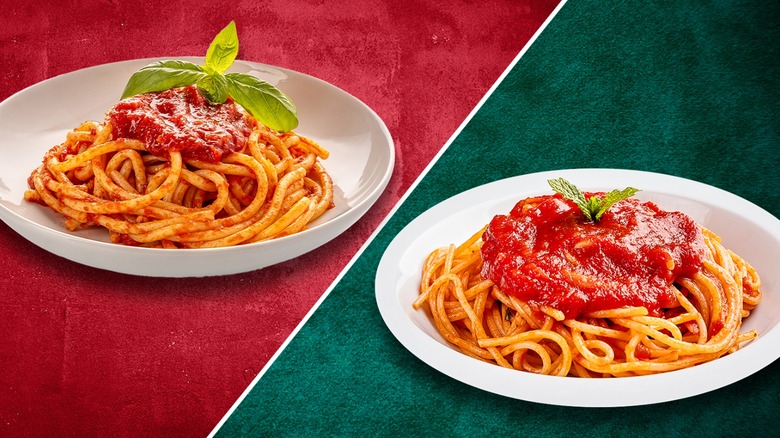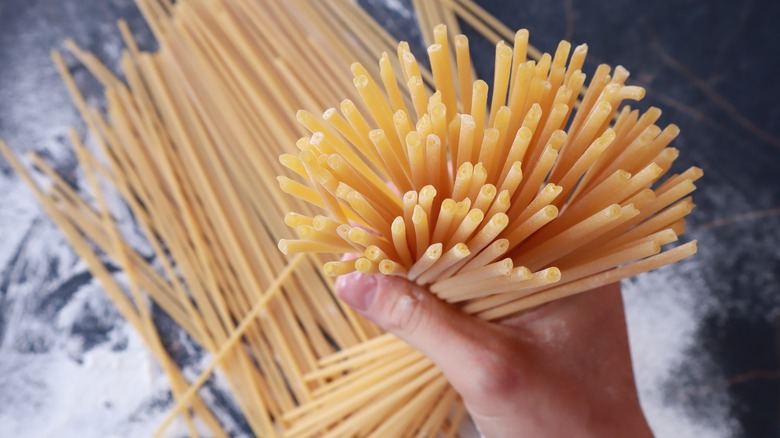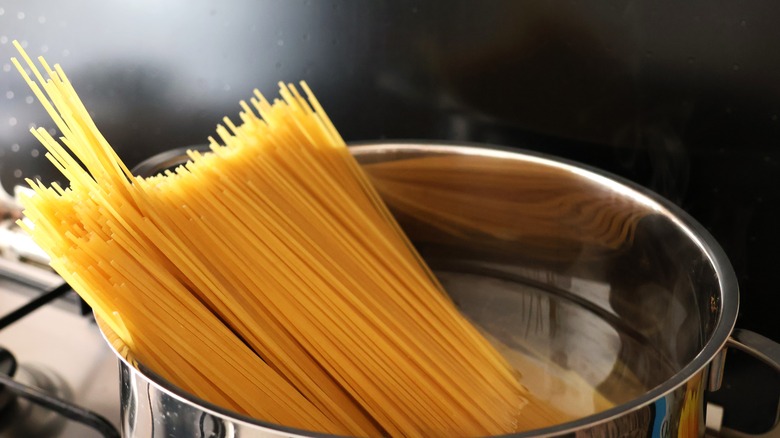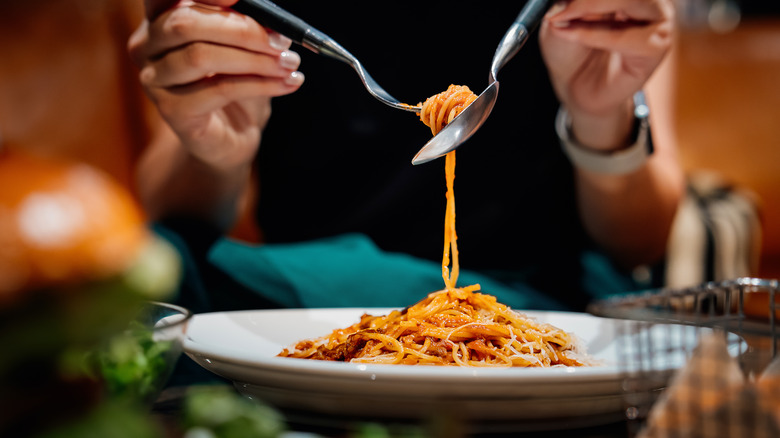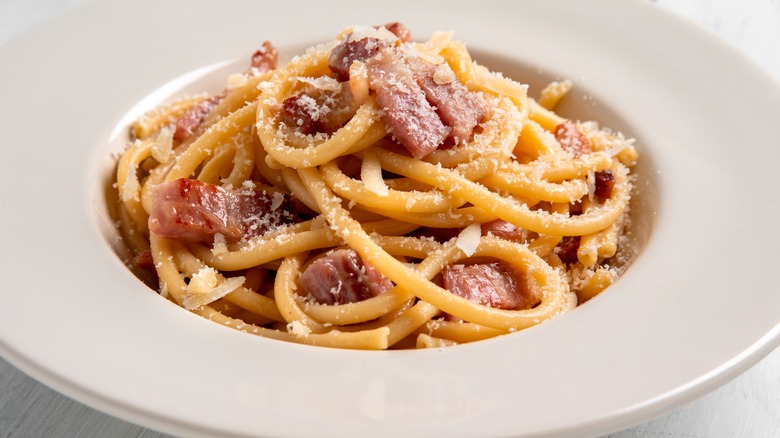Bucatini Vs Spaghetti: What's The Difference Between Pastas?
We may receive a commission on purchases made from links.
"They look so similar!" ravenous foodies might remark in a moment of hunger-induced misapprehension. "Spaghetti and bucatini are basically the same thing, right?" It's true that their long, thin shapes and comparable cooking times have led spaghetti and bucatini to be used interchangeably to make many of the same dishes. It's also true that they might even appear to be the same thing at a first glance. But, bucatini and spaghetti are totally distinctive pastas, and they're better at getting different jobs done on your plate and on your palate.
Today, spaghetti is the most popular type of pasta eaten in the world, according to Britannica. Foodies in Italy put away an estimated 52 pounds of spaghetti per person every single year, and Americans aren't too far behind with 20 pounds per person per year. But, if you've been sleeping on bucatini, it's time to wake up.
With long pastas, it's all about sauces that provide a lush coating, as opposed to smaller toothier pasta shapes, which are designed to accommodate meat chunks and heavy melted cheese. These long, thin, ribbon-cut pastas are both quick-cooking and easy to work with. One of their most appealing characteristics is that they perform well with even simple dressings like pesto, wine sauces, or simple butter. But, the biggest factor that separates bucatini from spaghetti is width. Regarding thickness, bucatini is to spaghetti as spaghetti is to angel hair — and bucatini is also hollow.
What is bucatini?
To describe bucatini as thicker, hollow spaghetti wouldn't be inaccurate, but it would be reductive. The pasta is shaped in long narrow tubes, like thin straws — meaning bucatini gets both coated and filled with sauce at the same time (a big deal). Bucatini performs best with bold, intensely flavorful sauces, as these flavor bombs can soak into the inner walls of the pasta.
The word bucatini comes from the Italian "buco" meaning "hole" plus the suffix "-ini," literally translating to "little hole." That signature little hole is created by a special tool called an extruder in the pasta machine: A perforated disk through which the pasta dough is pushed, forming a hollow tube. Due to this unique formation, bucatini cannot be hand-rolled like spaghetti and other flat types of pasta can.
Like spaghetti, bucatini is made from durum wheat flour and served with myriad different pasta sauces, from tomato to cream to meat and seafood sauces. Compared to spaghetti, bucatini has a shorter cooking time, getting boiled for seven to nine minutes until al dente. Retaining a toothy chew is essential for bucatini, so take care not to overcook.
Bucatini is also known as perciatelli, although this name mostly remains popular in Abruzzo, a region of Southern Italy roughly 66 miles east of Rome. Originally, bucatini comes from Italy's Lazio region (home of the Roma province), bearing both a historical link and enduring popularity to the dinner tables of Rome.
What is spaghetti?
Time to talk about the fundamental Italian pasta shape. The word spaghetti comes from the Italian "spago" meaning "string" or "twine." It's a thin, straight, cylindrical, medium-density pasta made from durum wheat semolina. It's typically cooked for eight to 14 minutes – notably longer than bucatini's cook time because, thanks to bucatini's center hole, each strand of pasta cooks from the inside and the outside at the same time.
Spaghetti is among the simplest types of pasta to make, requiring a straightforward, minimal combination of flour, eggs, water and sometimes olive oil – no special shaping techniques required. Perhaps its greatest claim to fame is its wild versatility. Spaghetti works as well in traditional Italian dishes as a substitute for instant ramen, although it's most commonly paired with lighter marinara sauce and a meatball or two. This isn't to say that spaghetti can never be used in tandem with heftier finishers. Spaghetti carbonara is a classic for a reason, after all, as is the richer sauce in spaghetti bolognese. But, as a general rule, spaghetti sauces air on the lighter side to avoid drowning the pasta.
Per the lore, spaghetti arrived in Sicily sometime in the eight century during the Arab invasion of the island. Spaghetti is thought to have been a regional Sicilian dish until the unification of Italy in 1860. The pasta officially cemented its Italian popularity during the 1800s when industrial factories were established in Italy, enabling spaghetti to be mass-produced and shipped nationwide.
Delicate spaghetti works better alongside thinner sauces
Spaghetti is solid and thinner than thicker, toothier, hollow bucatini. As a result, delicate spaghetti makes a better fit for lighter olive oil and garlic sauces like aglio e olio, as well as light cheese and cream sauces like alfredo. Dressed in these low-weight sauces, spaghetti's smooth, uniform softness can shine without getting weighed down or lost entirely. For compact, sauce-slathered bites, thin spaghetti can be easily twirled around a fork, while only two or three strands of thicker bucatini are going to be able to twirl around your fork tines at a time.
While tougher, al dente bucatini can hold up to heavier sauces like a meaty wild boar ragu, spaghetti would go limp under its weight. Even though spaghetti and bucatini appear ultra-similar, fusilli col buco, spaghettoni, or even thicker fettuccine pastas actually make better substitutes for bucatini than spaghetti.
Pro tip: Spaghetti can be gripped in a bundle and cracked in half for shorter strands, no problem. But, bucatini should never be cracked or broken, even after it has been cooked. Cook bucatini whole, then pile it neatly into the middle of the bowl plate to serve.
Bucatini has a hollow center and (usually) a higher price point
Bucatini is visibly thicker than spaghetti, featuring an outer diameter around 2.8 mm while spaghetti clocks in at a thinner 2.2 mm. In bucatini, the inner hole alone can range from 0.8 mm up to 3 mm in diameter in thicker versions. Also thanks to that center hole, bucatini holds onto sauces better than spaghetti. In the same way that penne, manicotti, and rigatoni can catch sauces in their cylindrical tube shapes, bucatini makes a natural vehicle for meaty pasta dishes like bucatini alla gricia with guanciale and bucatini all'Amatriciana with spicy pork and tomato sauce. Beyond these hearty marvels, bucatini also brings textural intrigue and a chewier bite to more understated dishes like cacio e pepe.
As somewhat of a specialty item, bucatini tends to run a bit pricier than spaghetti.High-quality brand Rustichella D'Abruzzo makes a knockout dried bucatini at just under $9 per pound on Amazon, while quality brand De Cecco makes durum wheat semolina spaghetti at $2.53 per pound. Still, many different brands of both bucatini and spaghetti can be found at a wide range of price points both in grocery stores and from online retailers, so foodies can satisfy their cravings at a price that suits their pasta budget.
